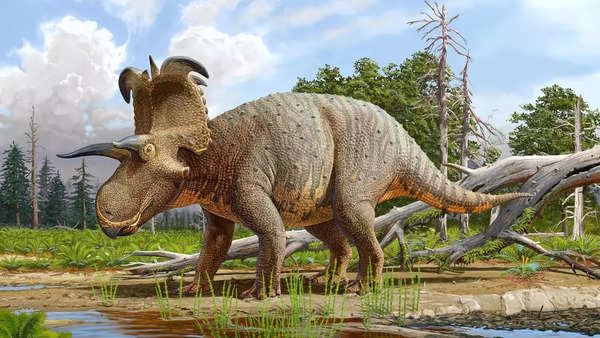Trending
Newly discovered giant species of dinosaur named after Thor's brother by scientists
Scientists have identified a colossal new dinosaur species named Lokiceratops rangiformis, found in Montana's badlands. Named after Norse god Loki for its horned helmet-like headgear, it lived 78 million years ago during the Late Cretaceous. Weighing over five tons and 22 feet long, it's the largest known centrosaurine in North America. This discovery enhances our understanding of dinosaur evolution and showcases the region's rich diversity of horned dinosaurs.

A newly discovered species of Dinosaur has been named after this Norse mythological figure by paleontologists due to the shape of its horns. Source: Courtesy of Museum of Evolution, Denmark, Loki/Walt Disney
A colossal new species of dinosaur, Lokiceratops rangiformis, has been identified by scientists, drawing its name from the Norse god Loki, known for his mischievous nature and iconic horned helmet. This remarkable discovery was made in the swamps of western North America, specifically in the arid badlands of northern Montana, near the Canadian border.The fossilized remains were unearthed in 2019, and after thorough analysis, the findings were published in June 2024.
The Lokiceratops, which lived approximately 78 million years ago during the Late Cretaceous period, is distinguished by its unique headgear. It boasted two prominent horns between its eyes and a spiky frill at the back of its head, adorned with the largest frill horns ever found on a dinosaur; reminiscent of the Norse god of mischief's regalia. This new species, weighing over five tons and measuring 22 feet in length, is now considered the largest dinosaur from the group of horned dinosaurs known as centrosaurines ever discovered in North America.

The skull of Lokiceratops was initially found by a commercial paleontologist and later acquired by the Museum of Evolution in Maribo, Denmark. Paleontologists Joseph Sertich of the Smithsonian Tropical Research Institute and Colorado State University and Mark Loewen of the University of Utah conducted the investigation of the specimens. Their research indicates that Lokiceratops rangiformis is a previously unknown species, adding to the diversity of horned dinosaurs in the region.
The horns of Lokiceratops, while impressive, were likely not used for defense, unlike the nose horn of a Triceratops. The absence of a nose horn in Lokiceratops suggests that its elaborate headgear served other purposes, possibly as ornaments for attracting mates or intimidating rivals of the same species.
This discovery has significant implications for our understanding of dinosaur evolution, particularly the ceratopsids. These dinosaurs were somewhat isolated from other geographic areas, which may have contributed to the unique horn shapes and the diversity observed in the fossil record. The Lokiceratops adds a new dimension to the evolutionary narrative of these majestic creatures.
Replicas made from casts of the Lokiceratops bones are on display at the Natural History Museum of Utah in Salt Lake City and the Royal Ontario Museum in Toronto. The original bones remain in Denmark, where they stand as an example of the rich prehistoric life that once thrived in what is now North America.
The naming of Lokiceratops rangiformis honors both the Norse mythology and the distinctive characteristics of the dinosaur. It also pays homage to Denmark, where the reconstructed bones are permanently exhibited. The choice of name reflects the collaborative nature of paleontology, where discoveries are shared and celebrated across borders and cultures.
The Lokiceratops, which lived approximately 78 million years ago during the Late Cretaceous period, is distinguished by its unique headgear. It boasted two prominent horns between its eyes and a spiky frill at the back of its head, adorned with the largest frill horns ever found on a dinosaur; reminiscent of the Norse god of mischief's regalia. This new species, weighing over five tons and measuring 22 feet in length, is now considered the largest dinosaur from the group of horned dinosaurs known as centrosaurines ever discovered in North America.

The dinosaur lived approximately 78 million years ago and is currently the largest horned dinosaur discovered in North America. Source: Courtesy of Museum of Evolution, Denmark
The skull of Lokiceratops was initially found by a commercial paleontologist and later acquired by the Museum of Evolution in Maribo, Denmark. Paleontologists Joseph Sertich of the Smithsonian Tropical Research Institute and Colorado State University and Mark Loewen of the University of Utah conducted the investigation of the specimens. Their research indicates that Lokiceratops rangiformis is a previously unknown species, adding to the diversity of horned dinosaurs in the region.
Lokiceratops’s habitat was once a swampy floodplain on the western shores of an inland sea that divided North America into two. The area is renowned among paleontologists for its variety of horned dinosaurs. With the discovery of Lokiceratops, there are now five known species of horned dinosaurs from this particular rock formation, suggesting a high level of diversity and specialization among these ancient creatures.
The horns of Lokiceratops, while impressive, were likely not used for defense, unlike the nose horn of a Triceratops. The absence of a nose horn in Lokiceratops suggests that its elaborate headgear served other purposes, possibly as ornaments for attracting mates or intimidating rivals of the same species.
This discovery has significant implications for our understanding of dinosaur evolution, particularly the ceratopsids. These dinosaurs were somewhat isolated from other geographic areas, which may have contributed to the unique horn shapes and the diversity observed in the fossil record. The Lokiceratops adds a new dimension to the evolutionary narrative of these majestic creatures.
Replicas made from casts of the Lokiceratops bones are on display at the Natural History Museum of Utah in Salt Lake City and the Royal Ontario Museum in Toronto. The original bones remain in Denmark, where they stand as an example of the rich prehistoric life that once thrived in what is now North America.
The naming of Lokiceratops rangiformis honors both the Norse mythology and the distinctive characteristics of the dinosaur. It also pays homage to Denmark, where the reconstructed bones are permanently exhibited. The choice of name reflects the collaborative nature of paleontology, where discoveries are shared and celebrated across borders and cultures.
Houthis' 'Encircle Israel' Plan Out; Fighters From North African Nations To Open New Front?
End of Article
FOLLOW US ON SOCIAL MEDIA










